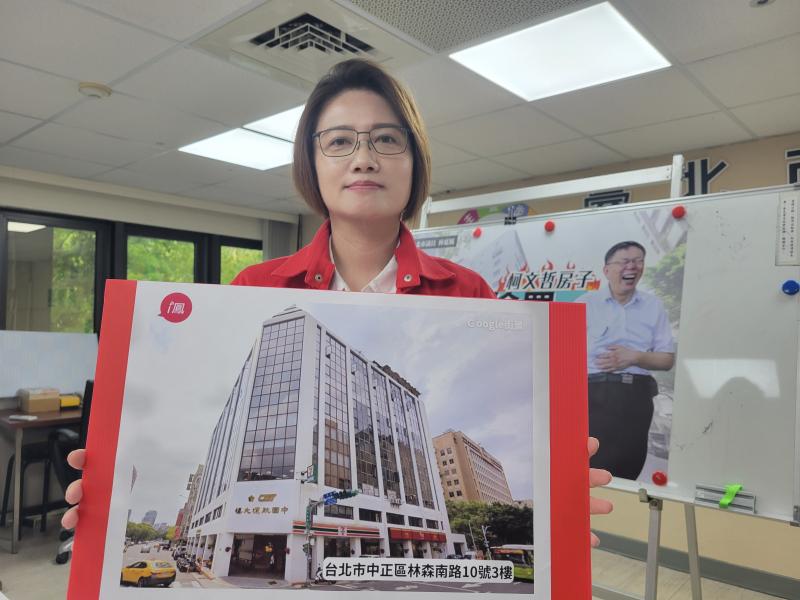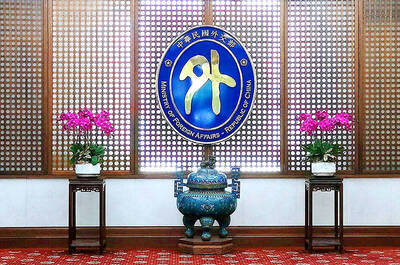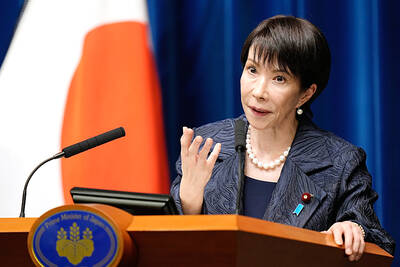Taiwan People’s Party (TPP) Chairman Ko Wen-je (柯文哲) today defended his purchase of office space near the Legislative Yuan, saying he followed conventional practice in using election subsidies to set up a personal office for long-term use.
Earlier in the morning, Democratic Progressive Party (DPP) Taipei City Councilor Lin Yen-feng (林延鳳) said that Ko on May 10 purchased 48.76 ping (161.2m²) of office space in Taipei’s Jinan Building (濟南大樓), spending NT$43 million (US$1.35 million) in cash and signing under his name.
Lin questioned where Ko got the money from, as the former presidential candidate and his TPP have been under scrutiny in recent weeks over irregular campaign finance reporting and unusually high spending.

Photo: Ho Yu-hua, Taipei Times
Speaking to reporters at TPP headquarters, Ko said that he followed the example of other political parties in allocating one-third of election subsidy funds to the party headquarters and two-thirds to the candidate.
Ko said he used the two-thirds allocated to him to set up a personal office, which he plans to use long-term.
Vicky Chen (陳智菡), who served as Ko’s deputy campaign chief, said there are two kinds of party election accounts: one for political donations, and another for subsidies allocated to an individual candidate.
Ko gave most of his candidate subsidy to the party and used the rest to purchase the office, she said, adding that former president Tsai Ing-wen (蔡英文) also had a personal office when serving as DPP chairperson.

The Ministry of Foreign Affairs (MOFA) yesterday voiced dissatisfaction with the Comprehensive and Progressive Agreement for Trans- Pacific Partnership (CPTPP), whose latest meeting, concluded earlier the same day, appeared not to address the country’s application. In a statement, MOFA said the CPTPP commission had "once again failed to fairly process Taiwan’s application," attributing the inaction to the bloc’s "succumbing to political pressure," without elaborating. Taiwan submitted its CPTPP application under the name "Separate Customs Territory of Taiwan, Penghu, Kinmen and Matsu" on Sept. 22, 2021 -- less than a week after China

THE GOOD WORD: More than 100 colleges on both sides of the Pacific will work together to bring students to Taiwan so they can learn Mandarin where it is spoken A total of 102 universities from Taiwan and the US are collaborating in a push to promote Taiwan as the first-choice place to learn Mandarin, with seven Mandarin learning centers stood up in the US to train and support teachers, the Foundation for International Cooperation in Higher Education of Taiwan (FICHET) said. At the annual convention of the American Council on the Teaching of Foreign Languages held over the weekend in New Orleans, Louisiana, a Taiwan Pavilion was jointly run by 17 representative teams from the FICHET, the Overseas Community Affairs Council, the Steering Committee for the Test of Proficiency-Huayu, the

A home-style restaurant opened by a Taiwanese woman in Quezon City in Metro Manila has been featured in the first-ever Michelin Guide honoring exceptional restaurants in the Philippines. The restaurant, Fong Wei Wu (豐味屋), was one of 74 eateries to receive a “Michelin Selected” honor in the guide, while one restaurant received two Michelin stars, eight received one star and 25 were awarded a “Bib Gourmand.” The guide, which was limited to restaurants in Metro Manila and Cebu, was published on Oct. 30. In an interview, Feng Wei Wu’s owner and chef, Linda, said that as a restaurateur in her 60s, receiving an

MORE RETALIATION: China would adopt a long-term pressure strategy to prevent other countries or future prime ministers following in Sanae Takaichi’s steps, an academic said Taiwan should maintain communications with Japan, as Japanese Prime Minister Sanae Takaichi is to lead a revision of security documents, Taiwanese academics said yesterday. Tensions have risen between Japan and China over remarks by Takaichi earlier this month that the use of force against Taiwan would constitute a “survival-threatening situation” for Japan. Prospect Foundation president Lai I-chung (賴怡忠) yesterday said Takaichi’s stance regarding Taiwan is the same as past Japanese prime ministers, but her position is clearer than that of her predecessors Fumio Kishida and Shigeru Ishiba. Although Japan views a “Taiwan contingency” as a “survival-threatening situation,” which would allow its military to